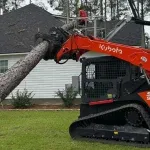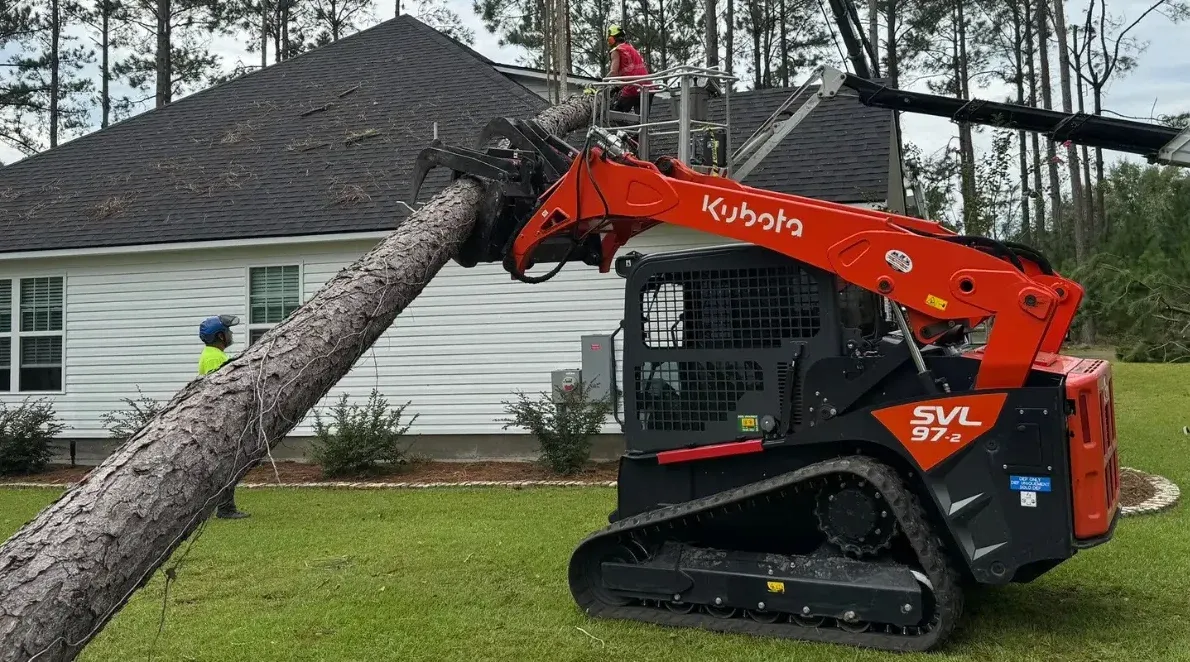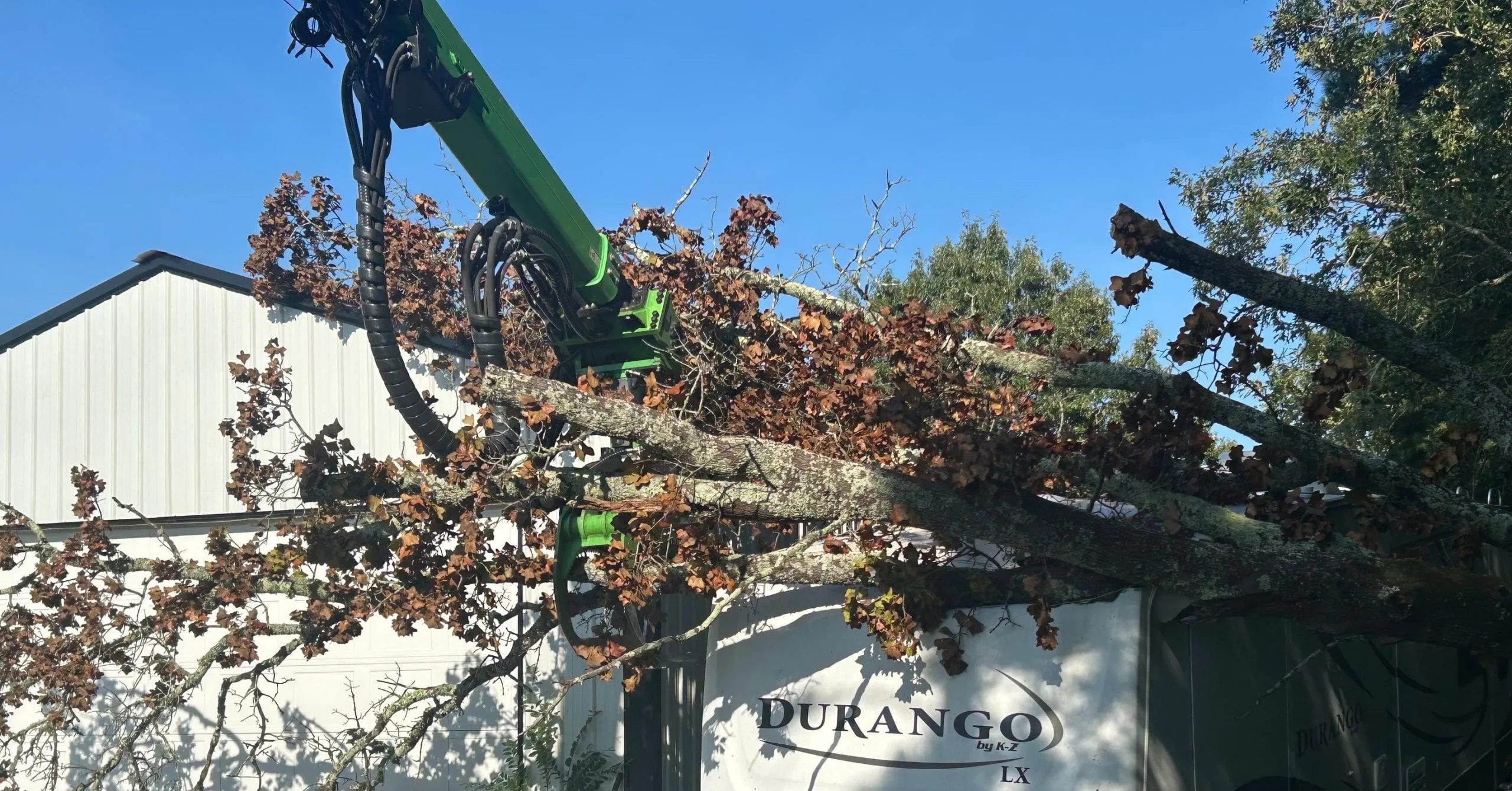August 6, 2025
One day it’s full of leaves, the next it just doesn’t look right, maybe it’s bare on one side, maybe the bark’s peeling, or maybe something just feels off. Trees don’t cry out when they’re sick. They decline in silence. And if you miss the signs, you could end up with a dangerous, dying tree right next to your house.
This guide breaks down what to look for, what might be causing it, and how to act before it becomes a costly problem. Whether you’re in Mississippi or anywhere with mature trees, knowing these signs can save your yard, and your wallet.
Early Warning Signs of a Dying Tree
You don’t need to be a tree expert to spot early trouble. Look for these signs:
- Leaf Issues
- Yellowing or browning leaves at the wrong time of year
- Wilting or curling leaves
- Sparse canopy or bare branches during growing season
- Branch and Bark Problems
- Brittle or dead branches that break easily
- Cracks in the trunk
- Bark peeling off or missing altogether
- Mushroom or fungus growth on bark
- Root Damage or Decay
- Exposed roots or root plate shifting
- Fungal growth at the base
- Soggy soil around trunk even without recent rain
- Pest Activity
- Sawdust piles at the base
- Holes in the bark
- Increased ant or beetle activity
Pro Tip: If a branch snaps clean and dry inside, it’s likely dead. If it bends or has green inside, the tree may still be alive.
How to Diagnose Tree Problems Accurately
If your tree looks “off,” don’t panic. It might be temporary stress from weather or pruning. Here’s how to tell the difference:
Step-by-Step Tree Health Check
- Walk around the tree and check all sides
- Compare it to nearby trees of the same species
- Use binoculars to inspect the upper canopy
- Look for sudden vs. gradual changes over time
When to Call a Professional
Some symptoms aren’t always obvious. Certified arborists use resistograph tools and core samples to assess internal damage. Call one if you see major dieback, leaning trunks, or if you’re unsure whether the tree is safe.
Common Tree Killers in North Mississippi
Knowing what typically affects local trees can help you act faster.
1. Fungal Diseases
- Root rot from compacted soil or overwatering
- Oak wilt spreading through root grafts
- Anthracnose causing leaf blight in spring
- Fusiform rust
- Annosus root rot
- Black knot
- Hypoxylon canker
- Needle cast
- Cedar apple rust
- Red heart
- Laurel wilt
- Heart rot (hardwood decay)
- Littleleaf disease
- Loblolly pine decline
2. Insect Pests
- Borers drilling into bark
- Aphids and scale feeding on sap
- Bagworms stripping leaves
- Southern pine beetle
- Ips beetle
- Black turpentine beetle
- Nantucket pine tip moth
- Eastern tent caterpillar
- Fall webworm
- Pales weevil
- White oak borer
- Pine webworm
- Locust borer
- Asian longhorned beetle
3. Environmental Stress
- Drought during high summer heat
- Flooding or poorly draining soil
- Construction damage around roots
Checklist: What to Watch For
| Symptom | Possible Cause |
| Bark falling off | Fungal disease or rot |
| Leaf curl or drop | Drought or pest damage |
| Soft wood near base | Internal decay |
| Holes in bark | Borer infestation |
How to Tell Pest Damage From Disease
Pest Damage Looks Like:
- Chewed or skeletonized leaves
- Entry/exit holes in bark
- Sawdust (frass) near the base
Disease Damage Looks Like:
- Leaf spots or blight
- Oozing cankers on bark
- Wilting or dieback on one side of tree
Tree Health Assessment Tools and Techniques
DIY Tools for Homeowners
- Binoculars to inspect canopy
- Soil probe for drainage and compaction
- Moisture meter for the root zone
- Pocket knife for a scratch test on twigs
Professional Diagnostic Tools
- Resistograph drill to detect internal rot
- Increment borer for age and growth analysis
- Lab tests for fungi, bacteria, or nematodes
The Science of Tree Decline: How Problems Progress
Stages of Decline
- Stage 1: Stress response (leaf loss, wilting)
- Stage 2: Chronic decline (dead limbs, sparse growth)
- Stage 3: Structural failure (rot, leaning, breakage)
How Stress Compounds Drought weakens the tree. That opens the door for pests. Then fungi enter through wounds. Problems often build up in layers, not all at once.
What to Do If Your Tree Is Dying
- Remove Dead Branches to reduce hazards and pest risk
- Water and Mulch Properly to support recovery
- Feed the Tree only if nutrients are lacking
- Apply Treatments if a confirmed pest or disease is present
Did You Know? Overwatering is just as harmful as drought. Always test the soil before watering again.
When Removal Is the Best Option
Sometimes, trees can’t recover. Signs it’s time to remove:
- Hollow or soft trunk
- More than 50% canopy dieback
- Deep cracks or splits
- Tree leans severely
- Roots lifting sidewalks or threatening foundations
If removal is necessary, hire professionals with insurance and the right equipment. Ask about stump grinding and root removal if you plan to replant.
How to Prevent Tree Loss in the Future
- Choose Native Trees that thrive in Mississippi conditions
- Plant correctly with wide holes, good spacing, and the root flare exposed
- Schedule Regular Inspections every 2–3 years
- Avoid Compaction near the root zone, especially during construction
Legal and Safety Considerations
- Permits: Some cities or HOAs may require approval for removal
- Liability: Homeowners can be held responsible if a known dead tree falls and causes damage
Tree Health Myths vs. Facts
- Myth: All mushrooms on a tree mean it’s dying
Fact: Not all fungi are harmful. But Armillaria and shelf fungi signal root decay
- Myth: Fertilizer can save any struggling tree
Fact: Fertilizer only helps if the soil is deficient. It won’t fix root damage or disease
Environmental and Community Impact
Healthy trees aren’t just personal property. They cool neighborhoods, reduce stormwater runoff, and support birds and pollinators. Removing one affects more than your yard.
Replanting Tips: Choose native species like bald cypress, oak, or black gum. These resist pests and thrive in local soil.
FAQs
Can a dying tree be revived?
Sometimes, yes. If caught early and the damage is from stress or pests, proper care can reverse decline. But if the structure is compromised or rot is widespread, removal is often safer.
What are signs a tree is too far gone?
Hollow trunk, large fungi at the base, multiple dead limbs, and significant leaning are red flags. A certified arborist can give a clear risk assessment.
Is it safe to leave a dead tree standing?
Usually not. Dead trees can fall during storms or high wind. They attract pests and may cause liability issues if they fall on property or people.
How long does a dying tree take to fall?
It depends on size, species, and cause of death. Some decay slowly over years, others collapse suddenly. Don’t wait for it to fall on its own.
Will cutting branches help a sick tree?
Pruning can help if done correctly. Remove only dead or damaged branches. Over-pruning can cause more stress.
Can I tell if a tree is dead in winter?
Check twigs: bend them gently. If they snap and are dry inside, they’re likely dead. Live twigs should be flexible and green underneath when scratched.
Should I fertilize a stressed tree?
Only if a soil test shows deficiency. Fertilizer won’t fix root rot, compaction, or other physical damage. Focus on watering and mulch first.
Who can I call for a tree health check?
Look for an ISA-certified arborist in your area. Avoid door-to-door offers or uninsured contractors.
Final Thoughts
Healthy trees are worth protecting. They offer shade, beauty, and safety when cared for properly. But when they decline, it’s important to act quickly and wisely. If you’re not sure what your tree needs, get an expert opinion. It’s better to know than to guess.
Still thinking things through? Reach out when you’re ready. We’re happy to help.








